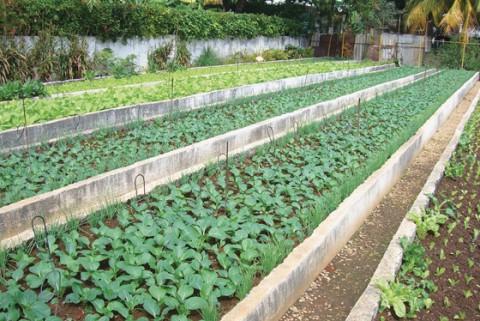Organic by necessity: Agriculture in Havana

Cuba is not a free country. It's hard to get around the fact that life is controlled by the state, and with that fact come many problems. There is a sense of collective unhappiness, even despair, which I would attribute to a basic lack of human agency. Economically, Cuba imports 84 percent of its food supply, including most of its meat and nearly all of its grain. That puts Cuba in the same food security category as Haiti, at least in terms of its reliance on foreign soil for nourishment.
In food production, the Cuban system supplies only 16 percent of the average Cuban's diet. Yet due to dire necessity, Cubans have gained a small victory in organic food production and are moving toward a more sustainable agriculture.
At one time the Soviet Union was Cuba's main trading partner, supplying the island with not only meat and grains but also fertilizer, pesticides, tractors and oil—all the standard trappings of industrialized agriculture. When the Soviet Union collapsed in 1991, Cuba was left scrambling to feed itself. Food disappeared from the shelves. Over the next three years, which Fidel Castro euphemistically dubbed "The Special Period in Peacetime," the average Cuban's daily caloric intake dropped from 3,000 to 1,800, well below what the FAO recommends as a daily minimum (between 2,100 and 2,300). Not enough people knew how to grow food; even fewer had access to land or tools or seed. If you were one of the 20 percent of Cubans who live in rural areas, you had a better chance of supplementing your limited food rations with wild coconuts and stray chickens. But if you were one of the remaining 80 percent in urban areas, you were entirely dependent on the state to feed you. Which means that for one out of three meals, you pretty much went hungry.
Read our latest issue or browse back issues.
During 1993-94, the worst of the Special Period, daily food intake was cut almost in half. Food on the shelves in grocery stores became not only prohibitively expensive but also scarce—even if you had money. Cubans were slowly, visibly starving.
Yet in the years since that time Cuba has realized a victory. Bill McKibben has called it "the world's largest working model of a semisustainable agriculture." Havana is hailed as having one of the best collections of organic urban gardens in the world, one in which farmers make three times the salary of doctors.
Why the sudden shift from slow starvation to thriving urban gardens? I asked that question at each of the three gardens I visited in mid-February, when I traveled there with a group of agricultural researchers. Cubans were proud of their organic gardens and had ample reason to be. But in my view, the country's sudden shift to organic agriculture and its accompanying shift toward more respect and better pay for farmers can best be described in one word: necessity. It's a word that could soon apply to food needs here in the U.S. too.
It is difficult for Americans to imagine the horrors of the Special Period. Since the end of World War II and the rise of petrochemicals, our supermarket shelves have groaned with every kind of food imaginable. We have come to believe that this is somehow natural, that access to such bounty is our right. But the reality is that we are racking up environmental debits to run our current system of food production. We are also borrowing vast stores of energy derived from ancient sunlight—oil—which is running out. The disaster in the Gulf of Mexico is not an anomaly but an inevitable by-product of our utter dependence on oil. We can't even eat without it.
One day soon oil will become too expensive to extract, making the price of oil too high to warrant using it for food production, and with that will come a collective cinching of American belts. The chimera of abundance down at the local Whole Foods will fade, the neon lights will grow dim, and hopefully we'll begin to take seriously the question Cubans asked during the Special Period: how are we going to feed ourselves without oil?
Cubans did not take a sudden interest in organic agriculture because they are smarter or greener or more environmentally savvy than other people. It came down to expediency. Without the fertilizers and herbicides once provided by the Soviets, their agricultural system imploded. They had to start over from scratch, which meant learning how to grow food the way people have grown it since the first wheat was planted in the Zagross Mountains of Iran 10,000 years ago.
When support from the Soviets stopped coming, the Cuban government got busy. Scientists were told to figure out biologic pest control, unused land was suddenly put into food production, and the few old men who still knew how to manage an ox team were called down out of the hills. To everyone's amazement, Cubans soon weaned themselves from petrochemicals and were growing food organically. Call it organic-by-default. But that didn't mean turning back the agricultural clock. While Cubans reclaimed some of the old methods of growing food, they also incorporated the latest agroecological knowledge gleaned from the best of modern research.
At the entrance to the organoponico on the corner of 5th and Miramar in Havana, I paused with other tour members under a pergola shaded by grape vines. A radio played softly in the background. On a table before us were healthy specimens of beets, chives, lettuce, radishes, bok choi and broccoli.
Roberto Perez Sánchez, the garden's director, is an agronomic engineer who has been working here since the early 1990s, when the garden became one of the first organoponicos, or organic urban gardens. Sánchez oversees seven workers, four of whom work in production and three in direct sales. The garden is a mere 1,800 square meters—not a large space given the amount of food that is grown there.
I am familiar with the difficulties of trying to grow as much food as possible in a limited space. For four years I was the director of Anathoth Community Garden, a church-supported agriculture project in Cedar Grove, North Carolina. We taught people how to grow food and supplied vegetables for roughly 30 families a week. Our mission came from Jeremiah, to "plant gardens and eat what they produce . . . and seek the peace of the city." I managed our one and a half acres like a small farm, planning crop rotations and planting in succession for continual harvest. It was a steep learning curve, but during those four years I learned a few things. Anybody can get out the rototiller, throw down some fertilizer and grow a crop of corn or squash. But to choreograph the intricate dance of several dozen crops on a small piece of land using only hand tools, knowledge and contemporary sunlight—that's an art form, one I will spend the rest of my life learning. I've only rarely met someone who does this well. Looking out over the raised beds in Sánchez's garden, I knew I had met a fellow artist.
Guarding the end of each four-foot-wide bed were marigolds and basil, a trick of the trade among organic gardeners who use these plants to deter pests. Sánchez described another method for pest control that was new to me: color bands. Insects orient themselves by color. In the forest, where there is a constant mix of colors that confuse insects, they can never decimate any one species. By alternating crops in every bed, gardeners mimic such a defense pattern here, Sánchez said. Interplanting alliums—chives, garlic, onions—with vulnerable plants like lettuce and bok choi further ward off attacks. If a particular insect infestation becomes too big a threat, Sánchez uses small amounts of biopesticides provided free by the state such as tobaccina, a spray made from tobacco leaves, or oil made from the neem tree, which also has insecticidal properties.
If they weren't using fertilizers, where did their fertility come from? Were they growing all their own compost? "No," Sánchez said, "our growing area is too small to cover crop." Instead they bring in cow manure from dairy farms just outside the city, which the state delivers to the various organoponicos to make into compost. In the 1800s, Paris relied heavily on draft power for transportation and used the resulting vast quantities of horse manure to grow vegetables year-round in the city's urban gardens. Havana is making similar use of this resource, turning what American cities consider waste into a valuable commodity.
The garden sells produce to the neighborhood six days a week. Eighty-five percent of the profits are distributed to the workers, 10 percent goes to the state, and 5 percent is reinvested in garden infrastructure. The average amount a garden employee earns is 1,500 Cuban pesos a month. Most Cuban doctors make roughly a third of that amount, while the average citizen makes as little as 25-300 pesos.
There are around 90 organoponicos around Havana, Sánchez said, all using similar agroecological farming practices.
"If the U.S. embargo were lifted," I asked him, "would you still farm organically?"
"Organics is the privilege of the Cuban people," he said. "Still, if the embargo lifts, then certain nonorganic fertilizers will become available, certain micronutrients and such, which I would use. I guess you could say that I'm not a purist."
Someone asked if there was still a sense of urgency in terms of food production, Sánchez said not so much—but that there needs to be. "The city is still a long way from being self-sufficient."
In Havana, nearly all of the vegetables and most of the fruit now come from within a 30-mile radius. This is an accomplishment of which few cities in the world can boast.
Bill McKibben warns that the old Earth we knew is no more, and that in its place we have "Eaarth," a place where humans are "hard at work sabotaging its biology, draining its diversity . . . we're running Genesis backward, decreating." One thing we can expect in the coming decades, McKibben says, is widespread food shortages. Britain's chief scientist predicts that by 2030, food and water shortages could create "a perfect storm."
McKibben proposes a kind of organic and oil-less farming that will require many more people than conventional farming. At Anathoth we had roughly ten people a week preparing the soil with hand tools—work that could have been accomplished by one person on a diesel-powered tractor. The Cuban gardens I visited followed the same pattern. "For a hundred years we've substituted oil for people," McKibben writes, "which is why we need to go the other way."
At Anathoth, we found that people did not see food production as drudgery but instead wanted to weed, dig and shovel. We can create good work opportunities and prepare for an oil-scarce future by reversing a trend. Let's substitute people for oil and plant more gardens.





